A DAY IN THE LIFE OF A BREWER
BY ANNE FITTEN GLENN | PHOTOS BY ERIN ADAMS
It’s 6:30 on a Thursday morning, and brewer Erin Jordan is walking from her home among the quiet streets of West Asheville to Archetype Brewing Company on Haywood Road. She unlocks the metal door to the building, formerly an auto body shop, and flips on some lights. Typically, at least one of Archetype’s two other brewers would show up, but today Jordan is running the brew house alone.
She keeps her long, dark hair off her face with a baseball cap turned backwards. She’s wearing a t-shirt and Carhartt overalls. She pulls on her waterproof, steel-toed boots and gets to work.
In a city like Asheville, celebrated for its award-winning craft beer industry, the job of a brewer is often glorified—perceived by the uninitiated to be one of those “cool jobs” that mostly involves drinking beer and trading recipes with other fun-loving beer enthusiasts. In reality, the work of a brewer at a small to mid-sized operation is demanding and tough, with long hours and a slew of routine tasks—many of which involve manual labor and heavy doses of cleaning and sterilizing.
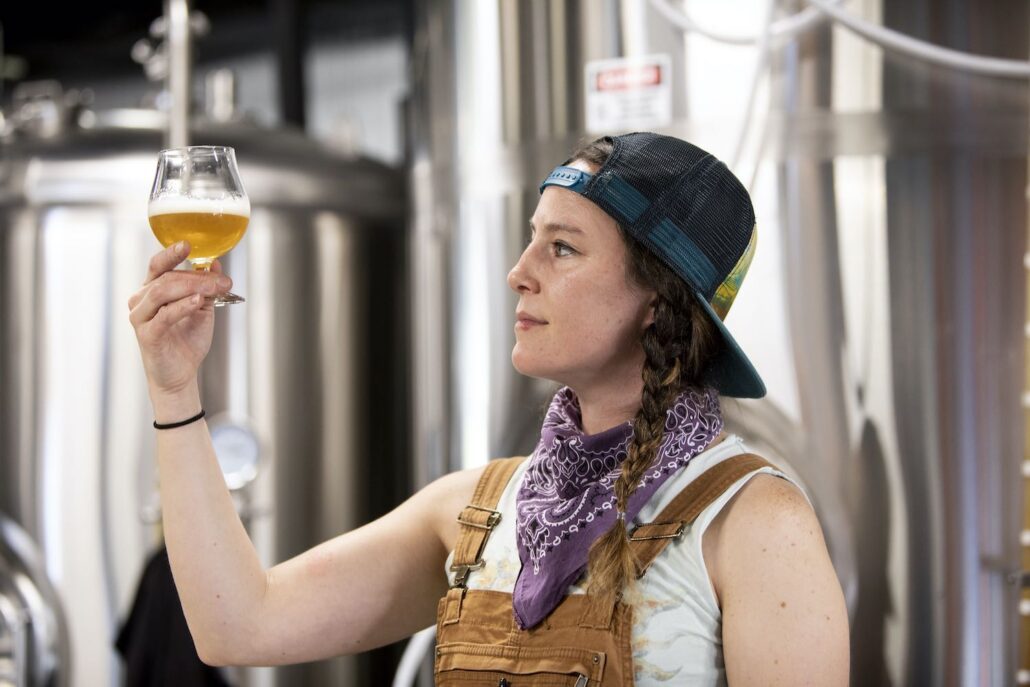
In some ways, Jordan is unique. The 33-year-old is self-taught and went from washing kegs to becoming the lead brewer in less than two years. She is also a woman in an industry still largely dominated by men. But in most other ways, her job is representative of the demands of a craft brewer, and following a day in Jordan’s life reveals all the hard work that goes into making beer.
Jordan was one of the first two employees hired by Archetype’s co-founders Brad Casanova and Steven Anan when the brewery opened in 2017. “I started working here when this building just had a dirt floor,” she says. “During build-out, I worked as an amateur electrician, an amateur plumber, and a gardener.” She and the first brewer, who was a man, joked that they should brew a beer called “Jack and Jill of All Trades.” They never did.
Jordan starts her morning on the brew deck. She watches as the malted grains mix with hot water to produce wort, the liquid base for beer. She milled and measured the malt the day before so she’d be ready to start first thing. She checks the beer’s recipe and makes sure the other ingredients—hops, yeast, and adjuncts—are measured and ready. She’s brewing a one-off beer called Will’s Dream, based on a recurring dream that one of Archetype’s bartenders keeps talking about. In the dream, Will makes friends at a musical festival by offering cold beer to the crowd, and Will’s Dream is a refreshing pale ale. Brewers in small breweries often get the creative freedom to brew special and whimsical beers, which Jordan appreciates.The “hot side” of brewing, aka the cooking part, mostly involves pushing buttons on the partially automated brew deck. It requires monitoring and overseeing the smooth transfer of hot liquid between stainless steel vessels. Once the beer is ready to boil, Jordan adds hops.
Then she gets down to the nitty-gritty of brewing—cleaning. Cleaning comprises a huge percentage of the actual work of brewing. Brewers like to joke that they are mostly janitors who occasionally cook up a beer. Jordan empties the 10-barrel vessel by hand, raking 500 pounds of steaming wet grain into bins. She then rolls these outside where a local farmer will pick up the spent grain to use as supplemental cattle feed.
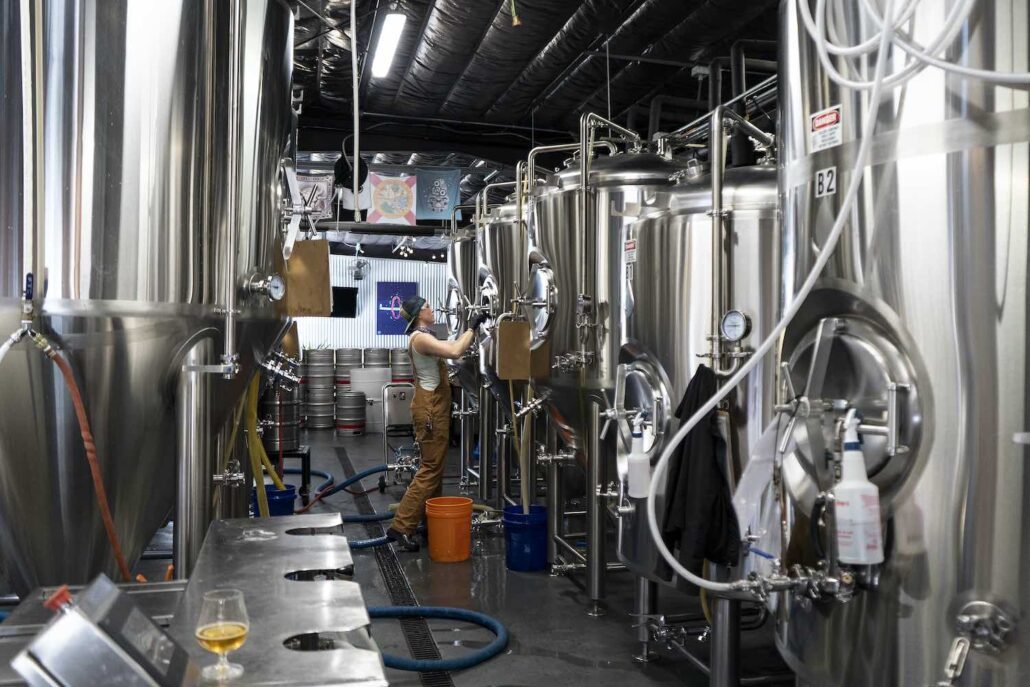
Jordan’s family moved to Asheville when she was 10, and she attended T.C. Roberson High School and then UNC-Chapel Hill. After college, Jordan wanted to attend medical school. To save money, she moved to Texas for eight years and worked as a scheduling coordinator for a healthcare company. She says the job was “soul-sucking” and changed her mind about med school. She wrote a list of what she wanted in a job, which included creative freedom, working with her hands, daily learning, and schedule flexibility. She says brewing for a small brewery gives her all of these things and more. “I melded two of my passions here—art and science,” she says. “And I love to learn. I absorb everything like a sponge.”
She’s sweating from the grain-out as she checks on the beers in the brewery’s cellar area. This is where the fermenting beers live until they are ready to be packaged. She checks temperatures and tests pH as well as other indicators of the developing beers. She smells and tastes each beer for quality control. She runs beer into pitchers from the bottom of the tanks to see what the yeast is doing, all the while adding notes to clipboards hanging from each fermentation tank. After each beer is packaged, she will input this data into the brewery management software.
Larger breweries often have a separate lab and full-time brewers who only brew or cellar. But Archetype is small enough, producing around 800 barrels of beer in 2019, that all three brewers engage in all aspects of production—from brewing to cellaring to quality analysis to packaging.
When Jordan moved back to Asheville from Texas, she found work managing a small café. She started home brewing and practicing food fermentation, both of which had long intrigued her. The café closed suddenly, and one of her regulars introduced her to Casanova, who was in the early stages of building Archetype. “I’m so lucky they gave me a chance, especially as a self-taught brewer,” she says. “Steven [Anan] has been a great teacher and mentor.”
While she works, Jordan constantly disinfects and sprays down nozzles, hoses, and anything else that beer or its byproducts have come into contact with. She regularly runs to check back on the beer that’s brewing.
Last year, Jordan slipped on an icy sidewalk and shattered her ankle. She insisted on returning to work only a week after surgery. “I’m stubborn,” she says. She couldn’t bear weight on the healing ankle, so she rigged a bucket seat on dolly rollers to get around the brewery. She claims this was faster and safer than trying to navigate wet floors on crutches. She’s still healing, but it’s difficult to tell as she climbs agilely up and down the brew deck ladder.
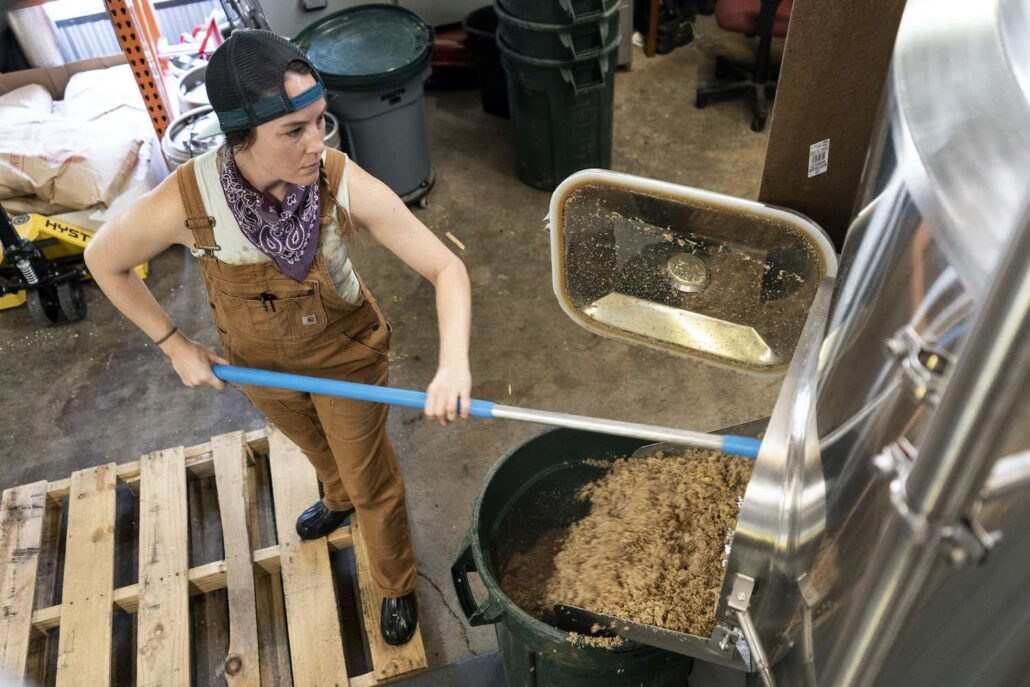
“Every day here is like coming to the gym. I’m lifting hundreds of pounds of grain and moving kegs,” she says.
The brewery’s delivery guy shows up. Archetype self-distributes its beer, mostly in kegs, to Western North Carolina restaurants and bars. The delivery guy is new, so Jordan helps him print out orders. A password snafu results in her having to call the software company. She again checks on the brewing beer while carrying a portable phone to wait for the reply call. Once she’s sorted that, the delivery guy loads up and heads out.
“We have to be flexible. The schedule can be derailed by technical issues and other unexpected problems,” she says. “Brewing takes a lot of planning and organization, but you have to be able to deal with having all your planning change in an instant.”
Once the brew is ready, Jordan transfers Will’s Dream into a fermentation tank that she cleaned the previous day. She adds yeast, the microorganism that, with time, will transform the liquid’s sugars into alcohol and carbon dioxide.
Today she eats leftovers from home for lunch while working. On less busy days, she walks home to eat. She spends an hour or so on the production office computer, working on scheduling, recipe development, writing standard operating procedures, and planning and preparing for the next day…and the next week…and the next month.
Currently, Archetype brewers don’t need to brew daily, although their schedule changes week to week. Like most breweries, this one closed except for take-out and delivery for more than two months because of the COVID-19 pandemic. Jordan was furloughed until Phase Two enabled North Carolina breweries to re-open with precautions and social distancing.
The brewery doesn’t have an in-house canning line, so on the day they hire mobile canning equipment, it’s a “long, all-hands-on-deck day,” per Jordan. Every beer must be ready at the same time for canning. Whatever beer isn’t canned is transferred to kegs or bottled. “You won’t understand the meaning of craft brewing until you have to fill and cork and cage 500 bottles, and then go back to hand-label them all,” Jordan says, laughing.
After canning, the team then brews heavily again to make sure there aren’t empty taps at Archetype’s two taprooms or lost taps at hard-won retail accounts. The brewery opened a second taproom on Broadway Street next to the Asheville’s Moog Factory in 2019. On non-brewing days, they clean and prep.
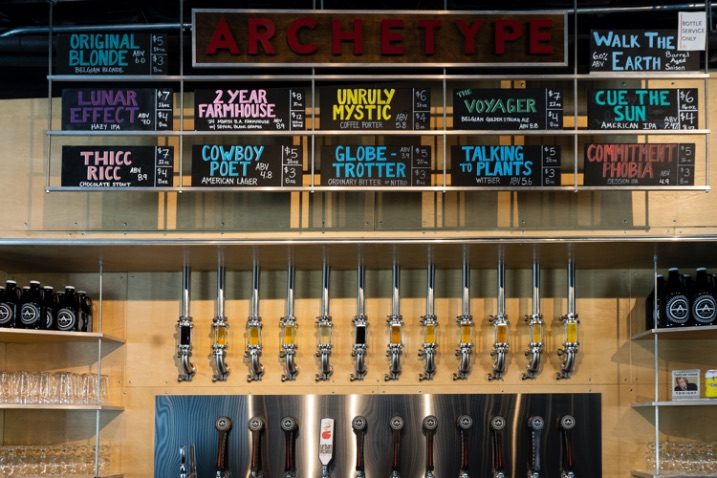
Today, Jordan ends her workday around 3 p.m. Some days she works from 9 a.m. to 5 or 6 p.m., but brewing days always start early as they can be unpredictable. A brewer can’t clock out if a beer isn’t done, no matter how many hours she may have worked that week, but some work days are shorter to make up for the long ones.
Sometimes after work, she’ll drink a beer in Archetype’s taproom with colleagues, family, or friends. Her partner, Erin Wilson (yes, they are Erin and Erin), is the director of development and communications at Asheville’s Boys & Girls Club and joins when she can.
Today, Jordan walks the few blocks back home, works out, plays with her dog and cat, and cooks dinner. Jordan’s parents and one of her two sisters live nearby. She and her partner and various family members are team regulars at Archetype’s trivia night.
She also likes to make time to visit other breweries. She’s organized and brewed a number of collaboration beers with other breweries, including Asheville Brewing, New Belgium, Hillman Beer, and DSSOVLR.
More women than ever before are brewing in Western North Carolina, but it’s still not many. There are maybe six or seven female brewers working in a total of around 75 breweries. “It can be challenging being one of the few, if not the only, woman, walking into a group full of men and being seen and valued for what you bring to the table,” Jordan says. Women tend to be hired as taproom or marketing staff. A few are in brewery management. Jordan notes she often has to correct people who think otherwise, by saying, “No, I’m the brewer.”
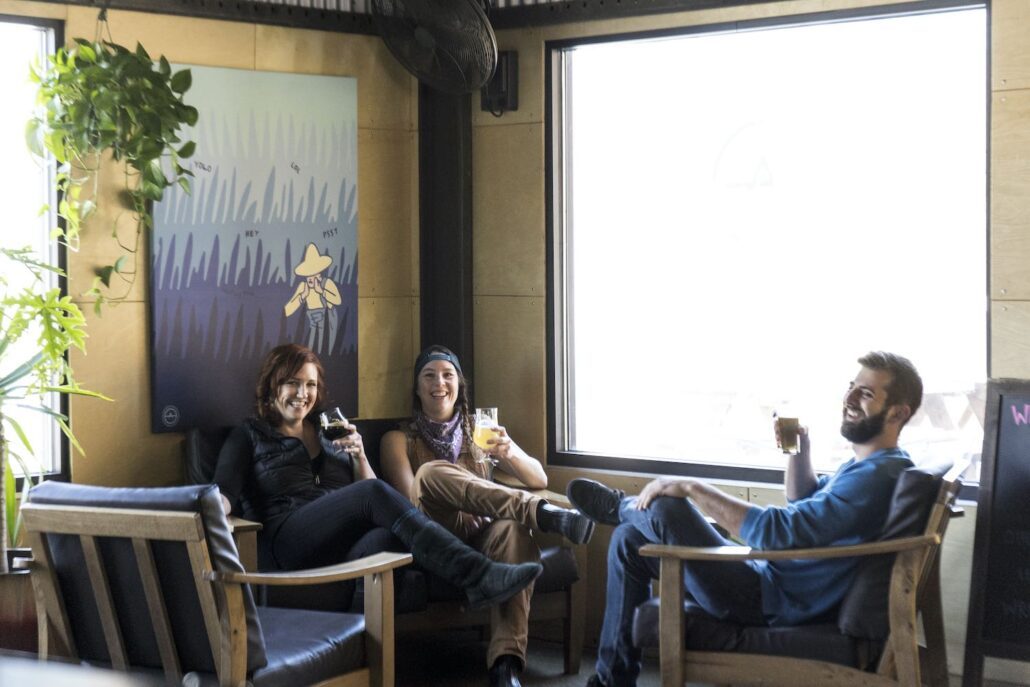
“Despite these things, it’s a great blessing and joy to have the privilege to say to other women, ‘You can do it,’” Jordan says. “You have a place here. It might take a little more fight, but in the end, it makes beer better.” She’s a member of Pink Boots, a nonprofit group that promotes women in the beer industry, and brews a beer for Biere de Femme, North Carolina’s annual festival benefiting the organization.
Archetype’s brewery shares space with the taproom, which means customers can engage with the brewers as they work. When the brewery opened, Jordan also worked as a bartender there, which she says she enjoyed.
“I loved getting true feedback, especially when customers didn’t know I was a brewer,” she says. “At the end of the day, we all just want to make a product that people enjoy.” ◊◊
As the former marketing director for a large brewery, Anne Fitten Glenn has lots of experience being the only woman in a room full of men. She’s the author of two regional history books: Western North Carolina Beer and Asheville Beer. She hosts a weekly radio show and podcast, Imbibe Asheville, which tells the stories of the past, present, and future of the beverage industry.
Save
Save
Save
Save
Save
Save
Save
Save
Save
Save
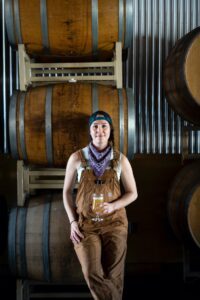
Erin Jordan of Archetype Brewing Company
THE WEEKLY REVEL
Sign up for your free handpicked guide to enjoying life around Asheville.
Available weekly from May to October.





